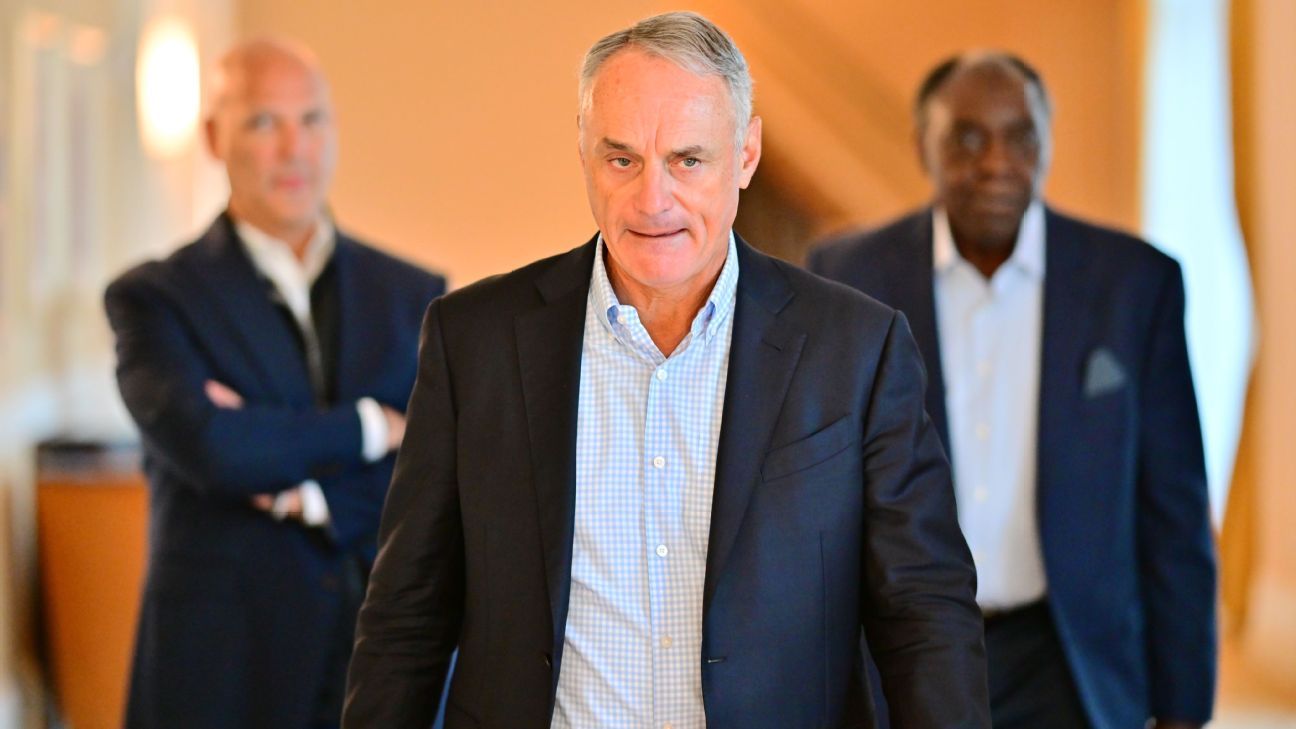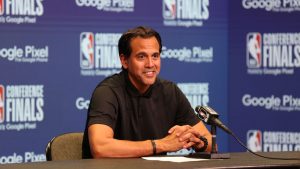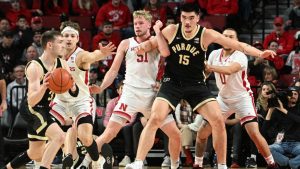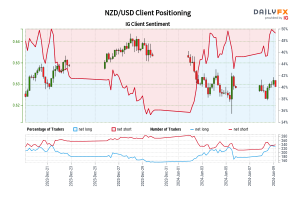[ad_1]
-

Jeff PassanESPN
Nah dran- ESPN MLB-Insider
Autor von „The Arm: Inside the Billion-Dollar Mystery of the Most Valuable Commodity in Sports“
MAJOR LEAGUE BASEBALL befindet sich in einer selbst verursachten Krise, einer selbst zugefügten Wunde, die zu gleichen Teilen aus Hybris, Kurzsichtigkeit und Sturheit von einer Klasse von Eigentümern getragen wird, die die Teams leiten und anscheinend Absichten haben, das Spiel in den Boden zu stürzen. Abgesehen von einer Wundereinigung in der elften Stunde am Montag über einen neuen Arbeitsvertrag, der die Aussperrung der MLB Players Association beendet, hat die Liga angekündigt, die Spiele am Eröffnungstag abzusagen. Dass Baseball am Abgrund einer so hässlichen Auflösung steht, ist kein Zufall. Es ist eine Studie über die Folgen von schlechtem Benehmen – von großen und kleinen Demütigungen, der Einhaltung des Buchstabens des Gesetzes, während es seinen Geist ignoriert, und, was am schlimmsten ist, der Entfremdung derjenigen, die den Sport großartig machen.
Die Spieler sind verärgert über den Verlauf der Verhandlungen, die sich seit fast einem Jahr mit wenig nachweisbaren Fortschritten hinziehen. Mehr noch, sie haben es satt, das Spiel zu sagen, das sie lieben, sowohl aktiv als auch passiv, es liebt sie nicht zurück.
Die Spielergehälter sind vier Jahre in Folge gesunken, obwohl die Einnahmen der Branche gestiegen sind und die Franchise-Werte in die Höhe geschnellt sind und die Möchtegern-Verwalter des Spiels jedem, der es hören wollte, plädierten, dass der Besitz eines Baseballteams kein besonders profitables Unterfangen sei. Die Dienstzeit der Spieler wurde manipuliert, um sie von der Entscheidungsfreiheit und der Gehaltsentscheidung abzuhalten. Die Luxussteuer, die eingeführt wurde, um außer Kontrolle geratene Ausgaben zu verhindern, hat sich in eine De-facto-Gehaltsobergrenze verwandelt, und zu viele Teams sind ohnehin weit davon entfernt, stattdessen ihre Dienstpläne auszuhöhlen und ihre Gehaltslisten zu kürzen, weil die Spielregeln einen Anreiz zum Verlieren bieten. Der Kommissar hat die World Series-Trophäe als „Stück Metall“ bezeichnet, und die Liga hat dem Team, das die beste Arbeit bei der Kürzung der Schlichtungsgehälter geleistet hat, einen Replik-Meisterschaftsgürtel verliehen.
Jedes davon ist ein Problem. Insgesamt dienten sie als Aufruf zum Handeln für die Spieler, die selbst jetzt noch Schwierigkeiten haben, das empfindliche Gleichgewicht zwischen Kummer und Trauer zu finden, während sie versuchen, ein größeres Stück eines Kuchens von über 10 Milliarden Dollar auszuhandeln. Die MLBPA wuchs in den späten 1960er und 1970er Jahren zur stärksten Gewerkschaft in den Vereinigten Staaten heran, indem sie Moral und Geld vereinte – indem sie gleichzeitig für sich selbst und für die Verbesserung des Spiels kämpfte. Jetzt, nach einem Vierteljahrhundert des Arbeitsfriedens und der damit einhergehenden relativen Selbstzufriedenheit, sind die Spieler energiegeladener und engagierter, als sie selbst erwartet hätten.
„Wir versuchen nur, uns nicht verarschen zu lassen“, sagte ein Spieler gegenüber ESPN.
So einfach es ist, auf das durchschnittliche Major-League-Gehalt (4,17 Millionen US-Dollar am letzten Eröffnungstag) als Zeichen dafür hinzuweisen, dass die Spieler bei nichts am falschen Ende stehen, es ist auch einfach. Finanzen im Sport sind ein Nullsummenspiel. Was nicht an die Spieler geht, geht an die Liga und die Teams, und die Eigentümer kontrollieren, wie ihre Teams Geld ausgeben. Seit dem Spielerstreik von 1994, der die World Series absagte – und insbesondere über die letzten beiden Tarifverträge – hat sich die Liga durch geschickte Verhandlungen als Angreifer positioniert, eine Rolle, mit der sie vertraut und vertraut geworden ist.
Am 2. Dezember, als die Liga einführte, was Kommissar Rob Manfred in einem Brief an die Fans als „defensive Aussperrung“ bezeichnete, handelte MLB zuerst – angeblich im Namen der Proaktivität. „Wir hoffen, dass die Aussperrung die Verhandlungen ankurbeln wird“, schrieb Manfred. Die Liga wartete dann 43 Tage, um der Gewerkschaft ihr nächstes Angebot vorzulegen.
Jetzt befinden sich die Mannschaften an einem weiteren Wendepunkt, einem mit der Fähigkeit, dem Spiel schweren Schaden zuzufügen – ein „katastrophales Ergebnis“, sagte Manfred kürzlich. Ohne einen Deal, sagt die Liga, werden Spiele verpasst und Spielergehälter verloren. Wenn Spieler nicht für 162 Spiele bezahlt werden, sagen sie, werden sie sich weigern, einer Erweiterung nach der Saison zuzustimmen, einem der Hauptziele von MLB bei jedem neuen Deal. Keiner weiß genau, ob der andere blufft.
Die Spieler wissen, dass sie der Liga nicht vertrauen, und diese Bedenken verstärken nur die Bedenken, die ihre 1.200-köpfige Gruppe bereits durchdringen. Die nächste grundlegende Vereinbarung wird den Sport im nächsten halben Jahrzehnt auf Gedeih und Verderb regeln, und die Spieler sind sich der Art und Weise bewusst, wie Front Offices, die immer den geringsten Vorteil gegenüber ihren Konkurrenten suchen, das Dokument nach Spielmöglichkeiten ausloten werden System zu ihren Gunsten.
Das richtige Geschäft zu machen, ist die einzige Möglichkeit für die Spieler, und ihre Position ist einfach: Der Sport muss sich mit seinen Bestrebungen weiterentwickeln. Baseball bleibt ein Spiel mit unglaublichen Vorteilen, mit einer Ansammlung von Spielern, die jung, dynamisch und überaus sympathisch sind. Es gibt viel Raum für Verbesserungen beim Sport selbst, der für eine breite Schar junger Möchtegern-Fans, die ihn als langsam und langweilig betrachten, zu schwerfällig geworden ist. Die Spieler haben sich darauf eingestellt, Spiele zu verpassen und mehr als 20 Millionen Dollar pro Tag an Gehältern einzubüßen. Sie glauben, dass eine schlechte Vereinbarung – eine, die versucht, ihre Macht weiter zu neutralisieren – noch mehr Schaden anrichten könnte.
Es könnte eine fehlerhafte Prämisse sein. Selbst wenn die Spieler die Lords of Baseball überlisten – wie John Helyar die Eigentümer in seinem unverzichtbaren Buch über die Geschichte des Arbeitskampfes im Spiel „Lords of the Realm“ nannte – könnte dies auch der inhärenten Natur der Eigentümer-Arbeiter-Dynamik entsprechen stark umzukehren. Aber in den letzten Monaten, als sie immer mutiger wurden, haben sie eine Stimme gefunden, die die MLBPA verloren hatte. Die Spieler wappneten sich dafür, hinter einer Sache zu stehen, die sich in der ganzen Masse als wahr herausstellte: das Richtige für das Spiel zu tun, das sie ihr Leben lang geliebt und gelebt haben.
AM TAG 89 der Aussperrung, da MLB bereit ist, das Spiel zu opfern, um seine Ziele zu erreichen, ist es wichtig zu verstehen, wie weit die Seiten voneinander entfernt sind – und warum die Erzählung, dass die Spieler in den Verhandlungen nichts Wesentliches aufgeben, falsch ist.
Die Spieler gingen ins Verhandeln und baten um den Mond, hatten aber eine schwache Hand, nicht gerade die Art von Kombination, die Veränderungen bewirkt. Sie skizzierten vier Schlüsselbereiche, die sie in der neuen Vereinbarung ansprechen wollten – Spieler früher in ihrer Karriere besser bezahlen, Manipulation der Servicezeit beheben, Teams am Tanken hindern und Beschränkungen der freien Entscheidungsfreiheit beseitigen – und griffen sie mit einer umfangreichen Reihe von Vorschlägen an . Einige, wie die Reduzierung der sechsjährigen Reserveperiode für einige Spieler, um die freie Hand zu erreichen, waren bei ihrer Ankunft tot. Andere, wie das Angebot eines Schiedsverfahrens für alle Spieler nach ihrer zweiten vollen Saison anstelle der standardmäßigen dritten, würden wahrscheinlich nicht an Bedeutung gewinnen. Mehr noch: Ein Anti-Tanking-Plan, der eine Draft-Lotterie einführen würde, um Teams für gewohnheitsmäßiges Verlieren zu bestrafen, und einen Bonuspool vor dem Schiedsverfahren, um die besten jungen Spieler zu bereichern, war zu sinnvoll, als dass die Liga ihn ignorieren könnte.[‚
What players had to give in exchange for their asks was simple, and the sort of thing that tends to carry the day in labor negotiations: money.
In the week leading up to the lockout, the players offered two chips with significant value. The first was expanded playoffs. Players have stayed firm at moving from 10 teams to 12 but balked at the league’s preferred format of 14 teams. Agreeing to it would provide MLB with a guaranteed $100 million from ESPN, which secured the broadcast rights for an expanded wild-card round. The second income stream would come from on-uniform advertising. Between uniform patches and helmet decals, teams would be expected to generate at least $150 million, according to sources. In all, the union can guarantee the league well over a quarter-billion dollars a year in new revenue — on the presumption that half of it will return to the players.
Certainly the league has taken steps toward some of the union’s more right-minded goals. MLB acceded to a lottery. It moved on service-time manipulation. From a financial perspective, however, players continue to wait for the league to match their outlay. The size of the disparity is unclear. The league offered to bump its minimum salary offer Sunday, sources said, something that will be worth tens of millions to players. The league’s bonus pool offer, last reported at $20 million, is another priority for the union. Draft bonus pools are expected to grow. Other changes offered by the league, such as implementing the designated hitter in the National League and scrapping a draft-pick penalty for signing free agents, have some value. The more guaranteed money goes to players, the likelier a deal becomes.
None of this is new, of course. Players organized in the 1960s to combat a cadre of owners who had hoarded profits for decades. What has changed is the size of the pot. A $1.3 billion-a-year industry after the strike octupled in size. That has done little to change the rhetoric among some ownership hawks whose desire for a salary cap is the desired endgame. Unlike the NFL, NBA and NHL, baseball’s uncapped system does not have a salary floor, allowing teams to spend as little as they want. The Pittsburgh Pirates‘ final payroll in 2021 was $50.3 million, their lowest since 2010 and less than one-fifth of the Los Angeles Dodgers‘. That disparity, baseball long has contended, could be ruinous for the sport. In his letter, Manfred wrote: „(T)he Players Association’s vision for Major League Baseball would threaten the ability for most teams to be competitive.“
It was classic MLB, the sort of fear-mongering the league long ago perfected. And though it’s undeniable that money does buy a team the ability to weather mistakes more easily, the notion that baseball needs a fixed system to solve a theoretical competitive-balance problem that the capped leagues avoid doesn’t stand up to something far more reliable than the desires of owners: history.
IN 2001, MLB commissioner Bud Selig went in front of Congress and spoke of baseball’s great financial woes. The sport had lost more than $500 million the year before, he told representatives who openly doubted the veracity of his numbers. Without a salary cap, Selig continued, not only might baseball need to contract two teams, it would never achieve competitive balance. That phrase has become baseball’s tried-and-true alarm bell, red meat for low-revenue markets. Selig didn’t get his salary cap, but a year later the league negotiated the framework of the competitive balance tax that exists to this day.
Since the CBT’s arrival in 2003, 13 MLB franchises have won the World Series and 19 have played in it. That is the exact same number of teams as in the salary-capped NFL, far better than the nine champions and 14 competitors in the salary-capped NBA and right there with the 11 Stanley Cup winners and 21 finalists in the salary-capped NHL. In the championship seasons prior to the CBT era, 14 organizations won the World Series and 20 made it. The CBT was about competitive balance like „Citizen Kane“ was about a sled.
Over that time, the CBT has risen, and the game has not collapsed. Baseball is too random for that, ever subject to the vagaries of chance. Always then, always now, always forever going forward, any restraint on spending will be about restraining spending. MLB sold the CBT as a way to rein in so-called runaway spending by the New York Yankees. Over time, though, the real intent — a salary cap in sheep’s clothing — revealed itself. The tax rates grew. Draft-pick penalties joined the fray. Of all the brilliant negotiating Manfred did during his time as the league’s lead labor lawyer, his work on turning the CBT from carrot to stick stands out. In September 2017, he said the quiet part out loud in an interview with a San Diego TV station.
„We have tried to deal with payroll disparity by limiting, through the use of taxes, the very highest-payroll clubs,“ Manfred said, adding: „For the first time in the 25 years since I’ve been in baseball, everybody in the top quartile of clubs had payrolls that actually went down this year due to the increased penalties that were negotiated as part of this collective-bargaining agreement.“
Nothing illustrates the evolution of the CBT quite as well as the 2021 season. Only the Los Angeles Dodgers and San Diego Padres exceeded the $210 million threshold. Five other teams, however, came within $3.4 million of it. MLB had orchestrated the coup of financial coups in collective bargaining: getting what amounts to a salary cap without a floor or a guaranteed revenue split.
The players noticed. They saw how over the previous two collective-bargaining agreements, the CBT threshold rose about 18% while industry revenues grew by at least 40%. They saw that in 2018, long before COVID existed, their average salaries went down — as they did again in 2019 and 2020 and 2021, even as the biggest deals in the sport were growing and $300 million-plus guaranteed contracts were no longer outliers. They saw franchise values exploding to the point that in 2021, Forbes estimated, the 30 MLB teams were worth a combined $55.28 billion. Ten years ago, only two collective-bargaining agreements earlier, their combined valuations were $15.68 billion.
They also saw teams continuing to mimic Selig’s rhetoric that baseball is little more than a break-even business. Whether MLB claiming a lack of profitability while boasting such gaudy franchise values and generating 11-figure revenues is voodoo accounting, intentional obfuscation or some combination of the two matters not. What does matter is the players saw it, and it infuriated them.
It was all part of the same bigger-than-the-game game the league was playing. Runaway spending leads to limiting through taxes. The six-year reserve period, so sacrosanct, turned into seven years when teams realized they could wheedle an extra season out of a player if they sent him to Triple-A out of spring training. To earn a full year of service, players need to spend 172 days on the major league roster. In his first season, NL Rookie of the Year Kris Bryant was on the Cubs‘ roster for 171. He filed a grievance. The arbitrator ruled in favor of the Cubs.
„It’s horrible,“ one general manager said. „Six years should be six years. But what are we supposed to do? Not take advantage of them?“
For teams, service-time manipulation was seen as a feature, not a bug. And as it had with the CBT, the league codified some of its greatest advantages at the bargaining table. After decades of getting dismantled at the table, MLB has in the 20 years since recruited a deep roster of top-notch labor lawyers and economists and succeeded in changing the paradigm beyond its wildest dreams.
As the agreements continued to worsen for the players, little embarrassments started to add up. The Cubs and the Houston Astros won back-to-back World Series in 2016 and 2017 after intentionally bottoming out to get better draft position. Because of the amateur draft pool first implemented in 2012, tanking for draft position — intentionally fielding a bad team — became a strategy.
Arbitration has always been a contentious process, and players were livid when they learned MLB celebrated tamping down salaries by awarding a championship belt to the team that did it best. During spring training in 2020, when MLB was reeling from widespread criticism by players that Manfred had been too soft on the Houston Astros for cheating during their championship run, he referred to the World Series trophy as a „piece of metal“ in an interview with ESPN’s Karl Ravech.
„‚Piece of metal‘ was the Gulf of Tonkin,“ one longtime baseball man said. „It was the aha moment for everyone. And then he did it again recently with everything about how owning a team isn’t that profitable. Treating players like they’re stupid has never worked. It’s never been a great approach.“
Baseball, it seems, can’t help from doing it, and it’s a symptom of those in ownership who regard players with disdain and struggle to stomach the notion that they warrant the salaries they receive. There are good owners, ones who prioritize winning above profits and understand baseball is wildly different from the businesses in which they made their billions.
Sports is a unique industry. Typically, workers make a product. In baseball, they are the product. The game of baseball is the framework, and in it exists two classes: players and owners. Players spend their entire lives chasing the major leagues. Just making it there is improbable. Staying long enough to make life-changing money is a miracle. Owners, on the other hand — at least those who don’t inherit their teams — join the baseball world just as they would a country club: by buying membership.
If you went and got the next 1,200 best players in the world, the product would suffer greatly. If you handed MLB teams over to any 30 competent businesspeople, the sport would not suffer. Actually, it might improve. It doesn’t take a billionaire to leverage a spot in a legalized monopoly with profound built-in revenues.
The Yankees are not the Yankees if Babe Ruth, Lou Gehrig, Mickey Mantle and Yogi Berra don’t win. Without the best players, they aren’t in the World Series, and without championships, they’re little more than an organization in a big market whose laundry features pinstripes. One would think, then, that a league would recognize that its profits exist because of Shohei Ohtani, Fernando Tatis Jr., Mike Trout, Juan Soto, Mookie Betts, Ronald Acuña Jr., Vladimir Guerrero Jr. and others — and would see players‘ concerns about the state of the game not as trivial or excessive or outrageous, but vital.
It took until two days before the league’s deadline, but MLB finally accepted the union’s idea of awarding a full year of service to players even if they didn’t spend 172 days on a roster — in this case, the top two vote-getters in each league’s Rookie of the Year balloting. After Manfred’s lockout announcement, his contention that investing in stocks is more profitable than owning a team and the general unwillingness of the league to acknowledge that maybe this group of players really is as united as it contends, the move registered less as an important concession and more as an addendum to the part of these discussions that isn’t moving — and could take Opening Day with it.
ON FRIDAY AFTERNOON, Manfred and Tony Clark, the executive director of the MLBPA, met at Roger Dean Stadium, the spring complex of the St. Louis Cardinals and Miami Marlins where the sides have met all week. Over the four previous days, bargaining had gone nowhere, and in a side session Manfred had asked Clark for a comprehensive proposal that included a move on the CBT. The league had stayed at $214 million and the union at $245 million since the lockout, and the union was under the impression that even if it made a small move on the CBT, the league would reciprocate with something more.
The next day, the union proposed what it considered major moves. It removed from the proposal any changes to the revenue-sharing system. It dropped its ask on Super 2s — the 22% of players with the most service time in each 2+ class go to arbitration a year early — from 75% to 35%. And it made that small CBT move, peeling $2 million off its asks in two years of the proposal. Some player leaders disagreed with the strategy, but representatives from all 30 teams signed off on it during a call.
MLB sent the proposal to owners, and back came an offer two hours later from lead negotiator Dan Halem and Colorado Rockies owner Dick Monfort, head of MLB’s labor policy committee. The meaningful counter the union expected instead was a $1 million raise on the CBT for one year and the reduction of overage penalties to 45% for the first threshold, 62% for the second and 95% for the third — all significantly worse than the 20%-32%-62.5% for first-time offenders in the expired basic agreement. The nonmonetary penalties — including the loss of a first-round pick in the amateur draft and the theoretical international draft for exceeding the third threshold — were still there, cementing the fact that the CBT that MLB is offering now is worse than the one that just expired.
When apprised of the offer, players‘ emotions varied. One said he was „furious — just incredibly pissed.“ Another: „Deflated. We thought this was going to get things moving.“ The league regarded the union’s offer as another in a long line of bad proposals — this one because MLB before the lockout already had told the union that revenue sharing and changes to Super 2 were nonstarters to ownership.
The league’s declaration of certain topics as off-limits never sat well with the players. This is, as MLB liked to say, a negotiation, and while revenue sharing could be seen as a third rail, expanding Super 2s — something that has been done multiple times in bargaining — belonged nowhere in that realm. Whether it’s real or the strategy is unclear, MLB’s line in the sand only fortified the players‘ belief that they had engaged in a monthslong charade.
The coming days will show how real the league’s threat of a hard deadline actually is. Multiple agents believe MLB is handling this like it does an arbitration case: Wait, wait, wait, and then at the last minute, when it looks impossible, get it done. Sunday brought some progress with more CBT discussion, though not the sort that less than 24 hours before a deadline offers much hope. Unless the league makes an unprecedented and entirely unexpected move in which it deviates significantly from its position on almost every key issue at the last minute and the union responds in kind, baseball will find itself in the same place it did in the summer of 2020: trying to figure out when the season will begin.
The fear and uncertainty of COVID’s early days clouded those negotiations, and Manfred said at a news conference following the lockout that he would not equate the two. If they’re not the same, they’re at very least related. Because the frustration that accompanied the lack of a deal and eventual implementation of a 60-game season by Manfred in 2020 only has grown in the time since.
In the meantime, players will do what they’ve been doing for months: sending one another messages about the current state of affairs and, more often than the commissioner may realize, screenshots of Manfred’s golf scores at Winged Foot, as found on Reddit. Gallows humor is the only kind that plays these days, when players‘ lives and livelihoods are interrupted for no good reason other than that the owners can.
Eventually, there will be a deal, and it’s likely that when there is, little will have changed about what one official called the game’s „mangled, Frankenstein economic system.“ The existential elements of the game — pace of play, capturing young fans, gambling — will have gone untouched at a time when real dialogue could’ve put the game in a far better position.
If there’s any hope for 2027 not devolving into something even worse than this lockout, those sorts of conversations should happen regularly and include players young and old, league officials and a cross-section of owners. Pivoting with an eye on the future is best way to salvage the sport and the damage this lockout has done. Though it’s not over, and may not be anytime soon, there are lessons to be learned to prevent baseball labor relations from taking a time machine back to the 1970s, ’80s and ’90s.
Already this is the second-longest period of labor strife in baseball history, and though it has stopped transactions and doused the hot stove and generally cast the sport in an awful light, until today, the most tangible thing lost was spring training. Soon, that won’t be the case. This is Rob Manfred’s disaster, the league’s disaster, the owners‘ disaster, and it’s been a long time coming.
.
[ad_2]
Quellenlink : www.espn.com











